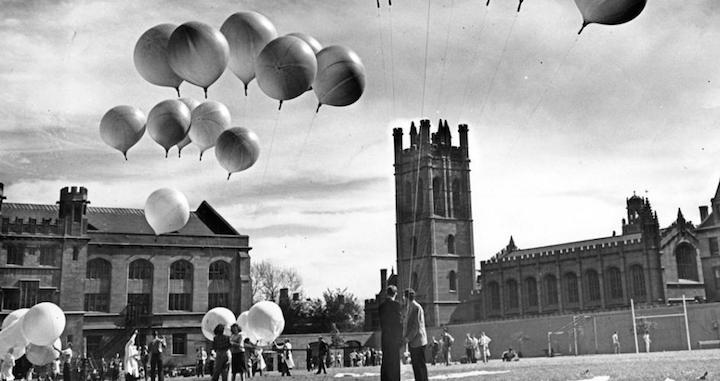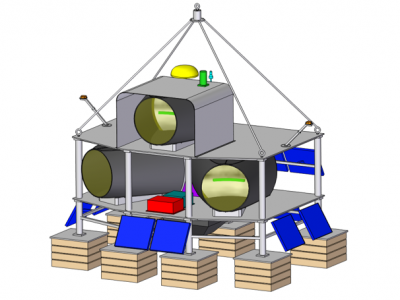25.10.2017

UChicago scientists have a long history of using balloons to study cosmic rays, such as this 1946 experiment at Stagg Field. A new NASA-funded balloon mission will use an ultra-sensitive telescope to pick up particles from deep space.
-
A team led by Prof. Angela Olinto was awarded NASA funding to fly an ultra-long duration balloon mission with an innovative ultra-sensitive telescope to pick up cosmic rays and neutrinos coming from deep space.
Planned for launch in 2022, the Extreme Universe Space Observatory on a Super Pressure Balloon is a major step toward a planned mission to send a probe to space. “This program will help us solve the great mystery of where in the universe these highly energetic particles are coming from, and how they could possibly be made,” said Olinto, the Albert A. Michelson Distinguished Service in Astronomy and Astrophysics.
The Earth is constantly hit by particles from space. One type is cosmic rays: sub-atomic nuclei traveling from every direction in space, accelerated by supernovas and other unknown cosmic phenomena. Similarly mysterious are neutrinos, the “ghost particles” that pass through us all the time, mostly undetected.
There is much we don’t know about them—most pressingly where they come from, although studies at the Pierre Auger Observatory in Argentina recently confirmed that the most energetic cosmic rays that hit the Earth are coming from beyond our own galaxy.
The most extreme cosmic rays and neutrinos offer the most clues to their origins and travels, as they can resist the effects of magnetic fields in space that curve the paths of weaker particles. These are what the new NASA-built balloon will be hunting.
“It’s very difficult to explain some of these particles using our current model of the universe,” Olinto said. “This balloon offers a truly unique opportunity to learn more about one of the great puzzles in astrophysics. In addition, once neutrinos are observed, we can test their interactions at energies well beyond what we can make in the laboratory.”
Taking measurements from space offers a much wider field of view to catch these rare particles, Olinto said. The Earth’s atmosphere makes these ghostly particles observable as faint flashes of light moving at ultra-high speeds. Hence the football-field-sized balloon, which can travel for months at 20 miles into the atmosphere, carrying the pioneering 3,000-pound telescope, which was built by an international team.
Three different mirrors will hang from the balloon, directing light toward two different types of detectors. One system is built to capture the radiation from extremely energetic neutrinos coming from the Earth below; the other is a fluorescence camera, which picks up the trails of excited nitrogen nuclei as cosmic ray showers cross the atmosphere.

The mission will launch from New Zealand, so that the balloon can catch a ride on the polar jet stream that circles the bottom part of the globe. The researchers hope the balloon will make several trips around the Antarctic over the course of 100 or more days.
The flight will provide proof of concept for the planned Probe of Extreme Multi-Messenger Astrophysics, a pair of orbiting satellites with the same capabilities, but with several orders of magnitude more sensitivity. A Olinto-led team of scientists and NASA engineers is designing the POEMMA mission for consideration by the 2020 Astronomy and Astrophysics Survey, which sets scientific priorities for the decade for NASA, the National Science Foundation and the U.S. Department of Energy.
POEMMA could offer some fundamental new insights about the universe, Olinto said. “For example, if there are extra dimensions of space, then the cross-section of neutrinos will change, and we should be able to see that.”
This is the second balloon launch to prepare for the space mission. The first balloon, which lifted off in April 2017 from New Zealand, sprang a leak early in the mission and sank into the Pacific. This new iteration will have much expanded scientific capabilities, Olinto said. An overnight test flight is planned in 2020 in the United States before the official launch in 2022.
In addition to the University of Chicago, the team includes the Colorado School of Mines, the Lehman College (CUNY), the Marshall Space Flight Center and the University of Alabama-Huntsville.
Quelle: University Chicago
